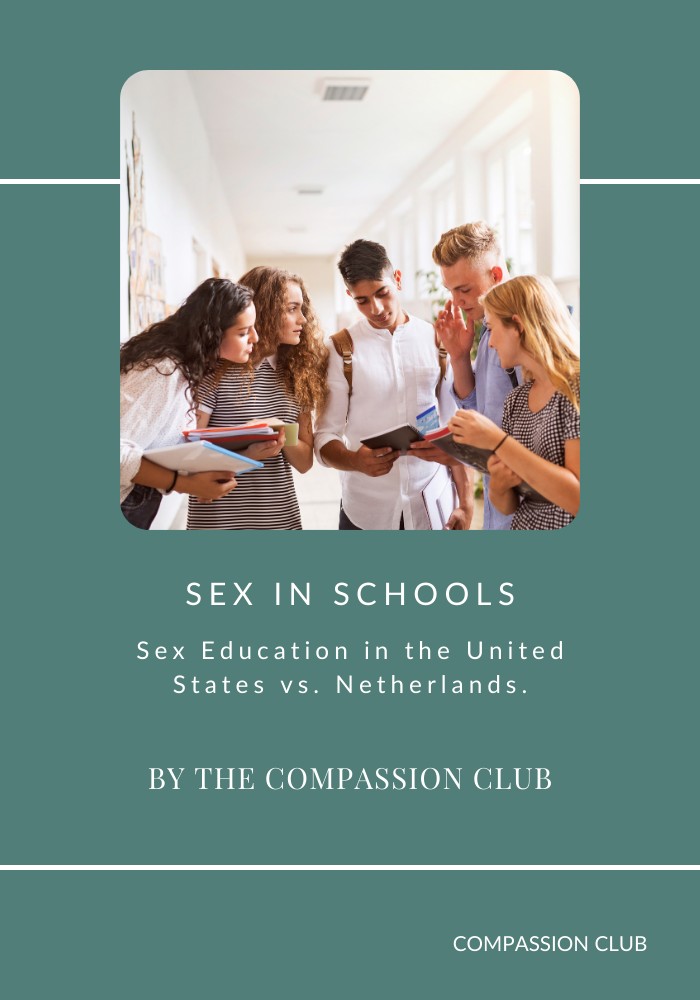THE COMPASSION CLUB
Sex In Schools : Sex Education in the United States vs. Netherlands.

Sex education in the United States vs. Netherlands.
Let’s compare apples to oranges.
Did this title alarm you a bit?
Well don’t worry, we’re only going to talk about this country’s most taboo subject. Which is sex education in public and private schools. This topic can get broad very quickly so I am going to do a comparison of two very different countries when it comes to sex ed, the United States and the Netherlands. Did you know sex education in the Netherlands isn’t even called ‘sex ed’? It’s referenced as ‘sexual education’ because educators believe there is a much bigger picture to this curriculum than sexual activity. The bigger picture is to have open, and honest conversations about love and relationships with their students.
This curriculum in the Netherlands is called ‘Spring Fever,’ and it begins at the age of 4 years old!
Kindergarteners are taught what it feels like to have a crush and develop feelings, and as these kids grow older and move up grade levels Spring Fever teaches them about self-image and gender stereotypes. Move up a grade level and you’re taught about sexual orientation and contraception options, move up again and you learn about being in love and the health of relationships and how sex plays a role in them. This is called comprehensive sex education.
“There were societal concerns that sexualization in the media could be having a negative impact on kids. We wanted to show that sexuality also has to do with respect, intimacy, and safety.” -Ineke van der Vlugt, an expert on youth sexual development in the Netherlands”
As I sit here writing this in the bible belt of Texas I already know some of you are shaking your head in disbelief or are just uncomfortable at the thought of this. And it’s okay because to each their own! This discussion isn’t meant to sway you in any different direction but merely to inform.
The results of this curriculum in the Netherlands have had very positive outcomes over the years.
– Young children at the age of 4 or 5 are taught the biological terms of body parts, they communicate better when an inappropriate encounter with an adult occurs. They can more quickly identify when they are uncomfortable or they are being touched in a way they shouldn’t be.
-Kids who went through this curriculum for their entire K-12 experience were said to be better communicators in their jobs when they graduated.
– The teenage birth rate in the Netherlands is one of the lowest in the world. While the U.S. remains one of the highest. This same ratio applies to HIV and STD rates.
What I have found most fascinating from reading more on this subject...
…is that boys throughout this curriculum are taught that they are not any less of a man when they show feelings or express emotion. And girls are taught that they have choices and should be confident in anything they choose to do.
So I ask you this, my uncomfortable readers: What is your take on this comprehensive curriculum? Especially parent readers: Would you be okay with the education system talking so openly about this subject with your child in every grade level? Or is this conversation strictly at home or not at all? Comment away!
MEET THE BLOGGER

Sex in Schools : Sex Education in the United States vs. Netherlands
Early education about biological terms, boundaries, and emotions leads to healthier adults. It results in lower teenage birth and STD rates compared to other countries. Teaching children that emotions and choices are human rights, not gender-specific, is crucial. Parents can prepare children for “Spring Fever” by having open, honest talks about bodily autonomy, relationships, and respect. This approach fosters a healthier understanding of sexuality and communication skills for children’s well-being and safety.